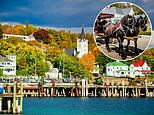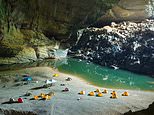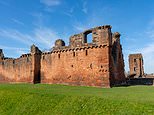Inside the largest abandoned town in Canada which has been left empty since 1935
- Urban explorer Dave visited a former mining base known as Anyox
- It was built in 1912 for mining and producing copper, silver, and gold
- However, it ceased operation in 1935 due to a collapse in copper prices
A fascinating documentary takes viewers on a tour of the largest abandoned town in Canada, which was once home to 3,000 people but then left to ruin in 1935.
Urban explorer Dave, who runs the YouTube channel Freaktography and does not reveal his last name, ventured to the wilds of British Columbia to explore a former mining base known as Anyox.
In the film's introduction, he gives some background on the far flung town's history explaining that it was originally built in 1912 by a company called Granby Consolidated Mining, Smelting and Power Company for 'mining and producing copper, silver, and gold.'
As the film shows a mix of vintage photos and modern day footage, he continues: 'During its 25-year existence, Anyox's mines and smelters produced four tons of gold, 230 tons of silver and 340,000 tons of copper.'
During the production process, Dave says that steam and electric locomotives were used to haul large quantities of ore from the mine on to the crusher, where it was reduced in size.

Urban explorer Dave, who runs the YouTube channel Freaktography and does not reveal his last name, ventured to British Columbia to explore a former mining base known as Anyox

The town was originally built in 1912 by a company called Granby Consolidated Mining, Smelting and Power Company for mining. Above, the impressive concrete dam

To visit Anyox, Dave enlisted the help of local tour guide Rob Bryce

'During its 25-year existence, Anyox's mines and smelters produced four tons of gold, 230 tons of silver and 340,000 tons of copper,' Dave explains
The final part of the process saw the crushed ore transported to the concentrator near the waterfront, where it was transformed into usable raw material.
In its heyday, 5,400 tons of ore were processed at Anyox per day, Dave says.
To power the operation, a concrete hydroelectric dam was installed, and at 156 feet high, it was the tallest structure of its kind in Canada for many years.
There were also coal fired generators at the mining site.
To visit Anyox, Dave enlisted the help of local tour guide Rob Bryce.
They took a four-hour drive from the city of Terrace to a former village called Kitsault, and from there, they took a boat ride to their final destination.
Describing what he saw as they neared the abandoned town, Dave said: 'It wouldn't be long until we spotted the tall brick smoke stack sticking out high above the trees.
'From there I would get to see with my own eyes, finally, the abandoned coking plant that greets all visitors to Anyox.

They took a four-hour drive from the city of Terrace to a former village called Kitsault, and from there, they took a boat ride to their final destination

Dave says one of the eeriest parts of Anyox is the cemetery. At one point he finds a gravestone from 1935 belonging to a man who died at the age of 70

There are also several graves belonging to WWI soldiers who returned to Anyox after military service to 'live out their lives' and work there
'[This was] followed by the general store, the power plant and then Granby Bay and the mountains that surround all of Anyox.'
The two men were greeted by Kevin Krogstad and Robbie Nutter, who are the sole occupants of Anyox and employed there to help shift the leftover slag.
To get around the vast site, they used ATVs.
Some of the sites Dave visits in the video include the tumbledown powerhouse, which once 'powered the mines, smelters and homes of Anyox,' the secondary power plant which is in even more of a disheveled state, what is left of the general store and the 'eerie' graveyard.
As he wanders around, the filmmaker finds remnants from past inhabitants including rusting bedframes, and even an old car.
He says one of the most unnerving parts of Anyox is the cemetery.

As he wanders around, the filmmaker finds remnants from past inhabitants including rusting bedframes, and even an old car

A fire 'swept clean the remains of Anyox leaving behind only the major concrete and steel structures which are still in evidence today'

While it was in operation, the town saw 480 births, 160 marriages and 320 deaths
At one point he finds a gravestone from 1935 belonging to a man who died at the age of 70, while many of the graves are unmarked.
There are also several graves belonging to WWI soldiers who returned to Anyox after military service to 'live out their lives' and work there.
Of the 400 men who left, less than 60 returned.
The ones who returned were 'promised a soldier's burial' by the town owners and their graves are differentiated by commemorative concrete helmets and cement borders.
Offering further insight into what life was like at Anyox and the hardships endured, Dave says: 'The copper mining town... was in operation between 1914 and 1935.
'During this time, [it] saw 480 births, 160 marriages and 320 deaths.

Many viewers have thanked Dave for sharing his video tour. One commenter wrote: 'This was an excellent explore. Such a great adventure, the waterfalls, the scenery, breathtaking'

To get around the vast site, they used ATVs before stopping to explore on foot
'Many of the deaths in Anyox were stillborn babies and infant deaths largely due to the toxic emissions from the smelter and the large scale cyanide waste.
'Additionally, the 1918 Spanish Flu pandemic is evident in the number of deaths [here] at that time.'
According to an article on the University of British Columbia website, Anyox ceased operation in 1935 due to a collapse in copper prices in the wake of the Great Depression.
The author explains: 'By early 1935 close to 50 million kilograms of unsold copper, the equivalent of three years' worth of production, were stacked near the harbor.
'When the mining operations shut down on July 31, 1935, and workers were laid off, the entire residents of the town lost their source of income and became homeless virtually overnight.

According to an article on the University of British Columbia website, Anyox ceased operation in 1935 due to a collapse in copper prices in the wake of the Great Depression

Adding to Anyox's demise, a forest fire broke out in 1946
'As to the buildings and mining sites, whatever materials there was to salvage was dismantled and shipped out to other towns and cities.'
Adding to Anyox's demise, a forest fire broke out in 1946. Anyox.com notes that the blaze 'swept clean the remains of Anyox leaving behind only the major concrete and steel structures which are still in evidence today.'
Many viewers have thanked Dave for sharing his video tour.
One commenter wrote: 'This was an excellent explore. Such a great adventure, the waterfalls [and] the scenery [are] breathtaking. Awesome job!'
Another viewer revealed their ties to the place, commenting: 'So much family history. My father was a teenager in Anyox and my grandfather was the general store manager, along with my aunt who was the bookkeeper!'



























































































































